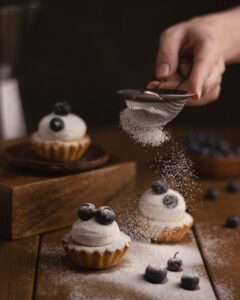The Science of Baking: How Ingredients Interact in Recipes
Science of Baking and art. Baking is a beautiful blend of both. While some might rely on intuition and family recipes passed down through generations, understanding the science behind baking can elevate your skills and help you create consistently delicious treats.
At the heart of this science is the intricate dance of ingredients in a recipe. Let’s delve into the fascinating world of the science of baking and explore how these ingredients interact.

Flour: The Foundation of Baking
Flour is the cornerstone of most baked goods. It provides structure through the formation of gluten, a protein network. When you mix flour with a liquid (usually water), the proteins gliadin and glutenin combine to form gluten. Kneading dough strengthens this network, giving bread its chewy texture. In contrast, for delicate pastries like pie crusts, minimal mixing is key to prevent gluten formation, resulting in a tender, crumbly texture.
Leavening Agents: The Rising Stars
Leavening agents, like yeast, baking soda, and baking powder, are responsible for that satisfying rise in baked goods. Yeast ferments sugars, producing carbon dioxide gas, which gets trapped in the gluten matrix, causing bread to rise. Baking soda and baking powder, on the other hand, release carbon dioxide when exposed to acids (like buttermilk or vinegar) or heat. This expansion of gas bubbles causes cakes and muffins to puff up, creating their airy texture.

Fats: The Flavor and Tenderness Enhancers
Butter, oil, and shortening are essential in baking, not just for flavor but also for texture. Fats coat the flour particles, creating a barrier that inhibits gluten formation. This results in tender, crumbly baked goods, like flaky pie crusts and melt-in-your-mouth cookies. Fats also play a role in flavor by trapping and enhancing the aroma of other ingredients.
Eggs: The Emulsifiers and Binders
Eggs serve multiple functions in baking. The proteins in eggs act as emulsifiers, helping to blend water-based and fat-based ingredients, creating a smooth batter. Eggs also provide structure and stability due to their proteins coagulating when heated, giving cakes and custards their firmness. In addition, the yolks contribute richness and flavor, while the whites can add lightness and aeration.

Sugar: Sweetness, Moisture, and Browning
Sugar goes beyond just sweetness; it plays a critical role in the texture of baked goods. Sugar absorbs water, preventing gluten development and yielding a tender crumb. It also aids in moisture retention, extending the freshness of your treats. Furthermore, sugar undergoes caramelization during baking, lending a desirable golden-brown color and a rich, complex flavor to baked goods.
Salt: The Flavor Balancer
Salt is often the unsung hero in baking. It doesn’t just add saltiness but also enhances other flavors by balancing sweetness and reducing bitterness. Moreover, it strengthens the protein structure, supporting gluten development in bread and providing a better texture in many baked items.
The Water Factor:
Water is frequently overlooked in baking, yet it’s crucial for various reasons. It activates leavening agents, helps dissolve and distribute other ingredients, and contributes to the formation of steam, which aids in the expansion of baked goods. The precise amount of water is often critical, as too much or too little can lead to undesirable results.

In the fascinating world of baking, each ingredient plays a unique role, and the way they interact is a delicate dance. Adjusting one element can have a domino effect on the final product. This is where the artistry of baking comes into play, as experienced bakers know how to balance and manipulate these ingredients to achieve the desired outcome.
So, the next time you embark on a baking adventure, remember that it’s not just about following a recipe but understanding the science behind it. Armed with this knowledge, you can confidently experiment and create your own delectable masterpieces, knowing how each ingredient contributes to the final result. Baking truly is a harmonious blend of science and artistry, where precision and creativity collide in a symphony of flavors, textures, and aromas.
